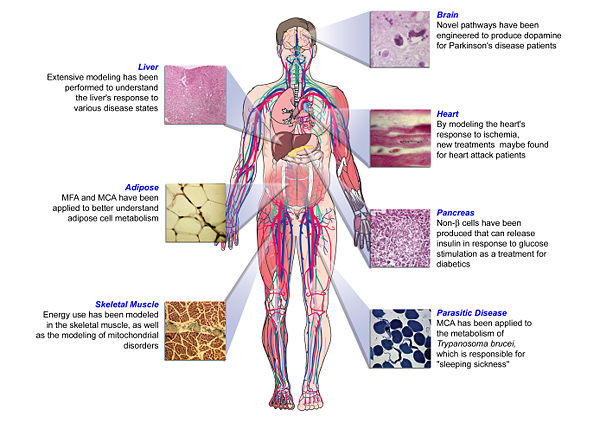Banta:ME: Difference between revisions
Scott Banta (talk | contribs) No edit summary |
Scott Banta (talk | contribs) No edit summary |
||
| (One intermediate revision by the same user not shown) | |||
| Line 1: | Line 1: | ||
{{Template:Banta_Lab}} | {{Template:Banta_Lab}} | ||
[[Image:body03.jpg|thumb|right|Summary of some of the medical applications to which metabolic engineering techniques have been applied. (Yarmush and Banta, 2003 Ann Rev Biomed Eng)]] | |||
[[Image:body03.jpg|thumb|600px|right|Summary of some of the medical applications to which metabolic engineering techniques have been applied. (Yarmush and Banta, 2003 Ann Rev Biomed Eng)]] | |||
'''Metabolic Engineering''' | '''Metabolic Engineering''' | ||
Latest revision as of 18:38, 24 June 2009

Banta Lab
Protein and Metabolic Engineering
| Home | Lab Members | Publications | Research Interests | Courses | Pictures | Positions Available |

Metabolic Engineering
Cellular metabolism is an intricate and highly evolved chemical network that allows a cell or organism to extract and utilize material from its environment to make useful products including primary metabolites, secondary metabolites, and high-energy molecules. The study of the metabolic capabilities of different cells has been an active area of inquiry for many years. Recently, the field of Metabolic Engineering has evolved which allows for the quantitative modeling and characterization of metabolic networks, and the engineering of metabolic networks to bring about a desired new goal. Metabolic engineering was originally developed and applied for use in prokaryotic systems, but recently it has been increasingly applied to eukaryotic systems and problems of biomedical interest.
Advances in the field of molecular biology have resulted in a set of highly effective tools for the rational alteration of metabolic pathways. Using these tools and techniques, including recombinant DNA technology, gene therapy, and antisense DNA techniques, it is possible to add, remove, and fundamentally alter metabolic pathways in almost any cell type. These approaches can be used to create cells and organisms with non-natural metabolic abilities, which can be used in both biotechnology and biomedicine.
We are interested in using the tools of metabolic engineering to compliment our research efforts in protien engineering. Metabolic modeling can be used to predict the impact of mutated proteins on entire metabolic networks. And new mutant enzymes can be created that will enable the design and construction of novel metabolic pathways.